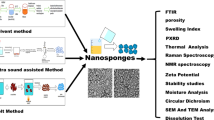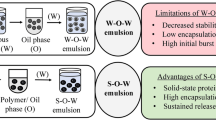Abstract
The effects of salt forming agents for chitosan on the potential for nanoparticle formation was investigated. The salt forms were prepared from the amino acid group, including glutamic and aspartic acids, and the alpha hydroxyl acid group, including lactic and glycolic acids. All types of chitosan salt could be used to prepare bovine serum albumin (BSA) loaded nanoparticles. The chitosan salts prepared from the amino acid group showed a higher salt formation ability as demonstrated using FTIR, hence a higher %encapsulation efficiency (%EE) and a reduction in zeta potential were obtained. The difference was due to the different organic acids used giving different polymer conformations and pH values in solution. Chitosan glutamate gave the highest salt formation ability and hence the highest %EE was obtained. The release of protein from all types of chitosan was similar and chitosan glutamate exhibited the highest release. Chitosan salt is therefore a material of choice for protein-loaded nanoparticles and the characteristics of nanoparticles can be readily modulated by different types of salt form.






Similar content being viewed by others
References
Agnihotri S, Mallikarjuna N, Aminabhavi T (2004) Recent advances on chitosan-based micro and nanoparticles in drug delivery. J Control Release 100:5–28
Ahsan F, Rivas IP, Khan MA, Torres Suárez AI (2002) Targeting to macrophages: role of physicochemical properties of particulate carriers—liposomes and microspheres—on the phagocytosis by macrophages. J Control Release 79(1):29–40
Boonsongrit Y, Mueller BW, Mitrevej A (2008) Characterization of drug-chitosan interaction by 1H NMR, FTIR and isothermal titration calorimetry. Eur J Pharm Sci 69(1):388–395
Calvo P, Remuñan-López C, Vila-Jato JL, Alonso MJ (1997) Novel hydrophilic chitosan-polyethylene oxide nanoparticles as protein carriers. Pharm Res 14:1431–1436
Casettari L, Illum L (2014) Chitosan in nasal delivery systems for therapeutic drugs. J Control Release 190:189–200
Chen F, Zhang ZR, Huang Y (2007) Evaluation and modification of N-trimethyl chitosan chloride nanoparticles as protein carriers. Int J Pharm 336:166–173
Douglas KL, Piccirillo CA, Tabrizian M (2006) Effects of alginate inclusion on the vector properties of chitosan-based nanoparticles. J Control Release 115:354–361
Gan Q, Wang T (2007) Chitosan nanoparticle as protein delivery carrier-systematic examination of fabrication conditions for efficient loading and release. Colloid Surf B 59:24–34
Gan Q, Wang T, Cochrane C, McCarron P (2005) Modulation of surface charge, particle size and morphological properties of chitosan-TPP nanoparticles intended for gene delivery. Colloid Surf B 44:65–73
George M, Abraham TE (2006) Polyionic hydrocolloids for the intestinal delivery of protein drugs: alginate and chitosan: a review. J Control Release 114:1–14
Graves RA, Ledet GA, Glotser EY, Mitchner DM, Bostanian LA, Mandal TK (2015) Formulation and evaluation of biodegradable nanoparticles for the oral delivery of fenretinide. Eur J Pharm Sci 76:1–9
He B, Ge J, Yue P, Yue X, Fu R, Liang J, Gao X (2017) Loading of anthocyanins on chitosan nanoparticles influences anthocyanin degradation in gastrointestinal fluids and stability in a beverage. Food Chem 221:1671–1677
Hejazi R, Amiji M (2003) Chitosan-based gastrointestinal delivery systems. J Control Release 89:151–165
Huanbutta K, Cheewatanakornkool K, Terada K, Nunthanid J, Sriamornsak P (2013) Impact of salt form and molecular weight of chitosan on swelling and drug release from chitosan matrix tablets. Carbohydr Polym 97(1):26–33
Huang GQ, Cheng LY, Xiao JX, Xiao-Na Han (2015) Preparation and characterization of O-carboxymethyl chitosan–sodium alginate polyelectrolyte complexes. Colloid Polym Sci 293:401–407
Ilium L (1998) Chitosan and its use as a pharmaceutical excipient. Pharm Res 15:1326–1331
Jung T, Kamm W, Breitenbach A, Xiao JX, Kissel T (2000) Biodegradable nanoparticles for oral delivery of peptides: is there a role for polymers to affect mucosal uptake. Eur J Pharm Biopharm 50(1):147–160
Ko JA, Park HJ, Hwang SJ, Lee JS (2002) Preparation and characterization of chitosan microparticles intended for controlled drug delivery. Int J Pharm 249:165–174
Kraisit P, Limmatvapirat S, Nunthanid J, Sriamornsak P, Luangtana-anan M (2013) Nanoparticle formation by using shellac and chitosan for a protein delivery system. Pharm Dev Technol 18(3):686–693
Lim ST, Martin GP, Berry DJ, Brown MB (2000) Preparation and evaluation of the in vitro drug release properties and mucoadhesion of novel microspheres of hyaluronic acid and chitosan. J Control Release 66(2):281–292
Limmatvapirat S, Limmatvapirat C, Puttipipatkhachorn S, Nuntanid J, Luangtana-anan M (2007) Enhanced enteric properties and stability of shellac films through composite salts formation. Eur J Pharm Biopharm 67:690–698
Lowry O, Rosebrough N, Farr A, Randall R (1951) Protein measurement with the folin–phenol reagents. J Biol Chem 193:265–275
Luangtana-anan M, Opanasopit P, Ngawhirunpat T, Nunthanid J, Sriamornsak P, Limmatvapirat S, Lim LY (2005) Effect of chitosan salts and molecular weight on a nanoparticulate carrier for therapeutic protein. Pharm Dev Technol 10:189–196
Luangtana-anan M, Limmatvapirat S, Nunthanid J, Chalongsuk R, Yamamoto K (2010) Polyethylene glycol on stability of chitosan microparticulate carrier for protein. AAPS PharmSciTech 11:1376–1382
Ma Z, Yeoh HH, Lim LY (2002) Formulation pH modulates the interaction of insulin nanoparticles. J Pharm Sci 91:1396–1404
Mao HQ, Roy K, Troung-Le VL, Janes KA, Lin KY, Wang Y, August JT, Leong KW (2001) Chitosan–DNA nanoparticles as gene carriers: synthesis, characterization and transfection efficiency. J Control Release 70:399–421
McClean S, Prosser E, Meehan E, O’Malley D, Clarke N, Ramtoola Z, Brayden D (1998) Binding and uptake of biodegradable poly-dl-lactide micro- and nanoparticles in intestinal epithelia. Eur J Pharm Sci 6:153–163
Pan Y, Li YJ, Zhao HY, Zheng JM, Xu H, Wei G, Hao JS, Cui FD (2002) Bioadhesive polysaccharide in protein delivery system: chitosan nanoparticles improve the intestinal absorption of insulin in vivo. Int J Pharm 249:139–147
Rampino A, Borgogna M, Blasi P, Bellich B, Cesàro A (2013) Chitosan nanoparticles: preparation, size evolution and stability. Int J Pharm 455(1):219–228
Sakuma S, Hayashi M, Akashi M (2001) Design of nanoparticles composed of graft copolymers for oral peptide delivery. Adv Drug Deliver Rev 47:21–37
Sarmento B, Ferreira D, Veiga F, Ribeiro A (2006) Characterization of insulin-loaded alginate nanoparticles produced by ionotropic pre-gelation through DSC and FTIR studies. Carbohydr Polym 66:1–7
Shu XZ, Zhu KJ (2002) Controlled drug release properties of ionically cross-linked chitosan beads: the influence of anion structure. Int J Pharm 233:217–225
Tsai ML, Chen RH, Ba SW, Chen WY (2010) The storage stability of chitosan/tripolyphosphate nanoparticles in a phosphate buffer. Carbohydr Polym 84(2):756–761
Vila A, Sanchez A, Janes K, Behrens I, Kissel T, Jato JLV, Alonso MJ (2004) Low molecular weight chitosan nanoparticles as new carriers for nasal vaccine delivery in mice. Eur J Pharm Biopharm 57:123–131
Xiong W, Zhang Q, Yin F, Yu S, Ye T, Pan W, Yang X (2016) Auricularia auricular polysaccharide-low molecular weight chitosan polyelectrolyte complex nanoparticles: preparation and characterization. Asian J Pharm Sci 11(3):439–448
Xu Y, Du Y (2003) Effect of molecular structure of chitosan on protein delivery properties of chitosan nanoparticles. Int J Pharm 250:215–226
Yuan XB, Li H, Yuan YB (2006) Preparation of cholesterolmodified chitosan self-aggregates for delivery of drugs to ocular surface. Carbohydr Polym 65:337–345
Zhang C, Ping Q, Zhang H, Shen J (2003) Synthesis and characterization of water-soluble O-succinyl-chitosan. Euro Polym J 39:1629–1634
Acknowledgements
This work was supported by the Research and Development Institute of Silpakorn University. This project would have been impossible without the facilities provided by the Department of Pharmaceutical Technology, Faculty of Pharmacy, Silpakorn University.
Author information
Authors and Affiliations
Corresponding author
Ethics declarations
Conflict of interest
All authors declare that they have no conflict of interest.
Rights and permissions
About this article
Cite this article
Luangtana-anan, M., Nunthanid, J. & Limmatvapirat, S. Potential of different salt forming agents on the formation of chitosan nanoparticles as carriers for protein drug delivery systems. J. Pharm. Investig. 49, 37–44 (2019). https://doi.org/10.1007/s40005-017-0369-x
Received:
Accepted:
Published:
Issue Date:
DOI: https://doi.org/10.1007/s40005-017-0369-x




